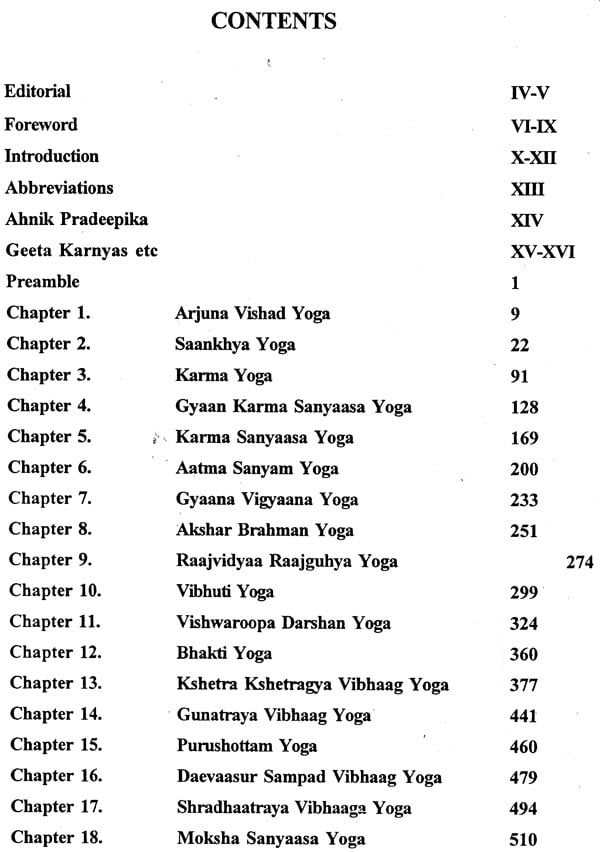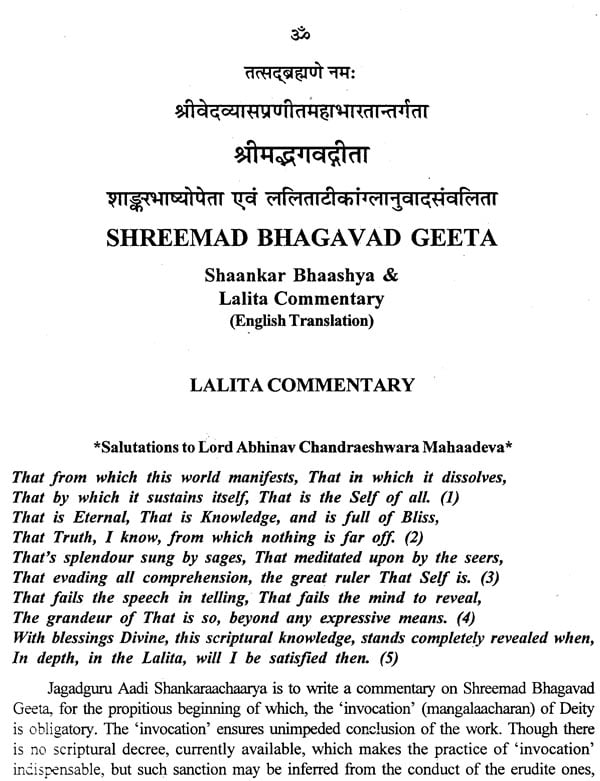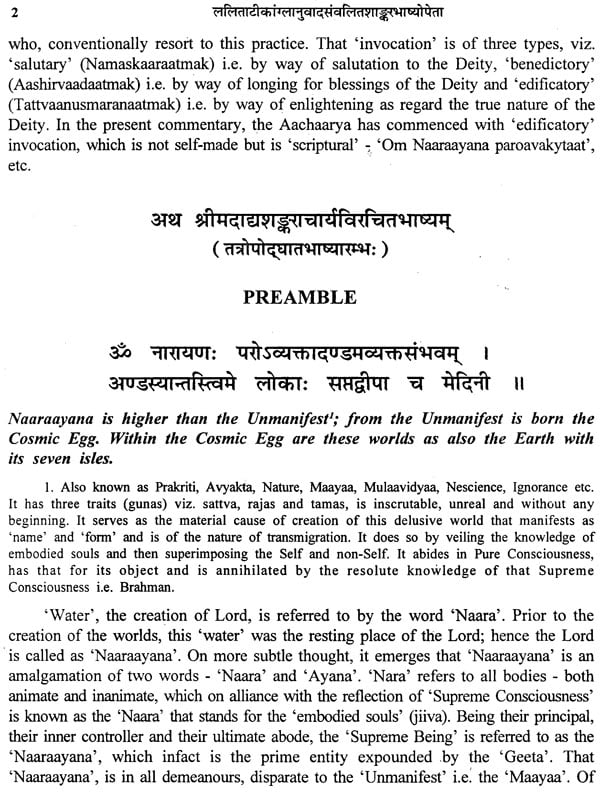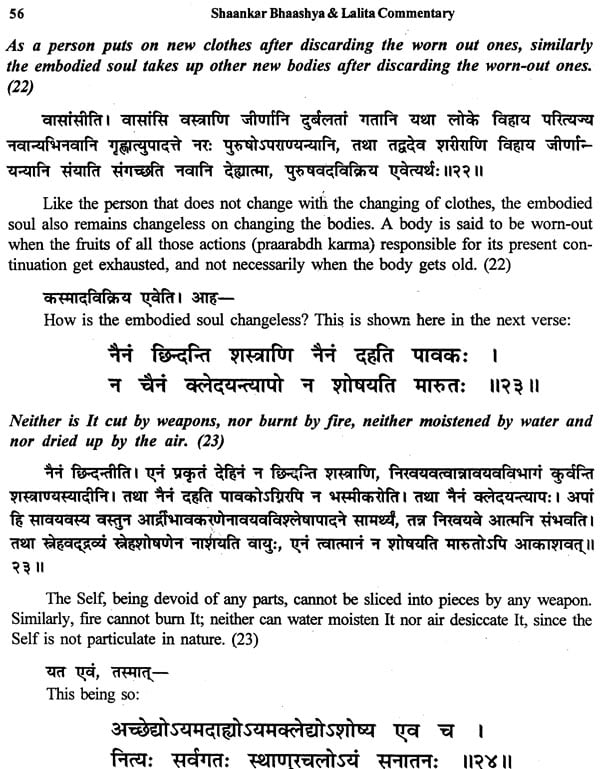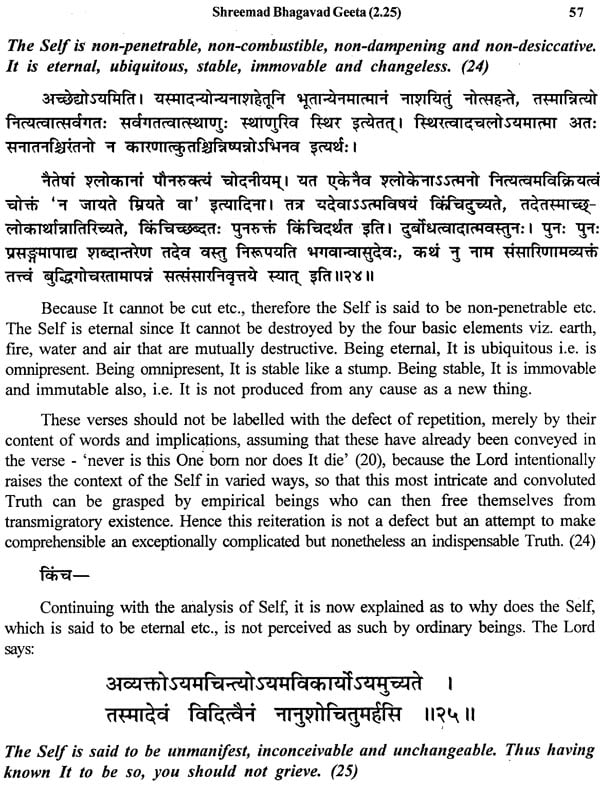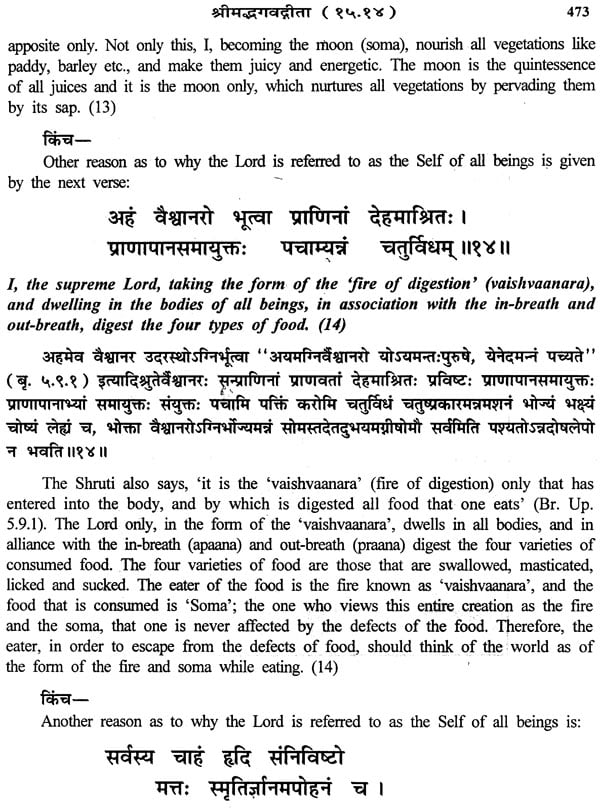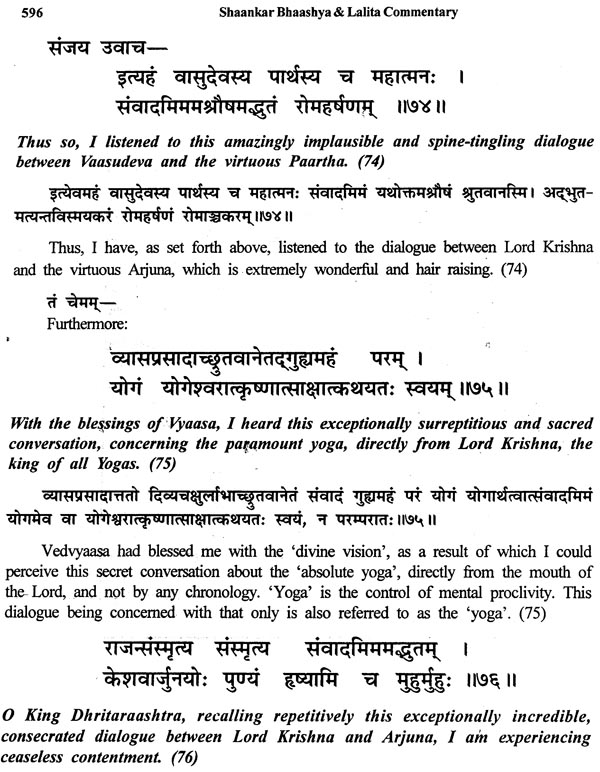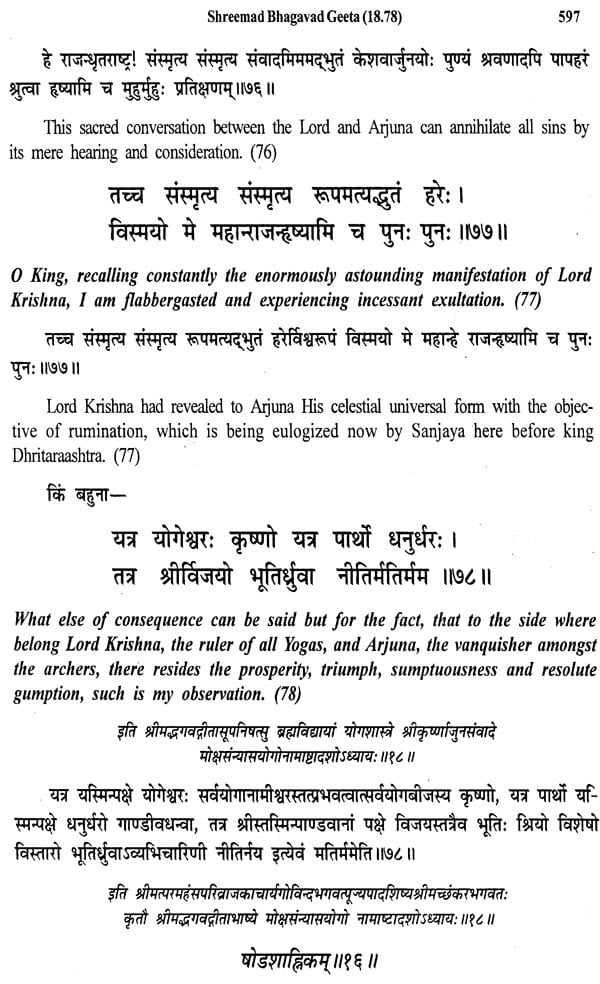
श्रीमद्भगवदगीता: Shrimad Bhagavad Gita with Shanker Bhashya and Lalita Commentary (Kailash Ashram Edition)
Book Specification
| Item Code: | HAA557 |
| Author: | Swami Vidyananda Giri ji maharaj |
| Publisher: | Shri Kailash Ashram, Rishikesh |
| Edition: | 2002 |
| Pages: | 613 |
| Cover: | Hardcover |
| Other Details | 10.0 inch X 7.5 inch |
| Weight | 1.20 kg |
Book Description
According to the above verse, making Arjuna, the son of Pritha as the medium, Lord Narayana incarnating as Shri Krishna, milked the essence of the Ur nishadas, the crown of Vedas, in the form of Geeta which brings forth what may be called a drizzle of matchless Nectar on its readers. The world knows that Lord Vedavyasa has only scripted, in the Epic called Mahabharata, what the Lord spoke in the battlefield of Kurukshetra. Mahabharata is such a treasure which caters to the welfare of the entire world and what is not included in Mahabharata, is not to be found anywhere else. It is said that all the preachers and philosophers of the world only repeat whatever has been said by Vedavyasa. Therefore we all owe a debt to Sage Vedavyasa.
Shrimad Bhagwad Geeta is acknowledged as a universal marvelous holy scripture on which one finds commentaries and translations in all important languages. Among the commentaries on it in Sanskrit, the one written by Adi Jagadguru Shankaracharya is par excellent. Sub-commentaries and translations, in Sanskrit and other languages, of 'Shankar's commentary' (Bhashya) itself have also been authored, which reveal the depth and importance of the Shankra Bhasya.
Geeta has been divided into eighteen chapters. Shankaracharya has not written any commentary on the first chapter and the first ten verses of the second chapter, since this portion of Geeta does not propound any particular 'principle' that requires to be elaborated. However, Shankaracharya has written a preface which sums up the import of the aforementioned verses adequately.
In the commentary of Shankaracharya, the elucidation of words of the verses is just appropriate. Any more addition to it may perhaps be considered unnecessary. But where the question of grasping the principles arose, there the pen of Adi Shankaracharya flowed without any hindrance, which was no doubt essential to comprehend the purport of Bhagwad Geeta. 'The false one does not exist' (9Mth fq7A fir), on such statements the thoughts of Shankaracharya are extremely worthy. The special elaborations in Geeta reflect very clearly the dictum of Shankaracharya that God is truth, the world is false and the Self is God only and not different from It. It is the conclusive view of Shankaracharya that the principal means of emancipation is the direct knowledge of oneness of Self and the Lord, for which it is absolutely necessary to listen to the words of Upanishads direct from the preceptor after renouncing the world. A monk has the first right to listen to Vedantic knowledge; other aspirants fall in the second line. In the absence of all the required means, an aspirant should, with whatever wisdom he has, take recourse to disciplines like listening etc. In this manner he will stepwise achieve direct knowledge of the Self and attain salvation.
In order to possess the above eligibility, the performance of Action Yoga and Worship are also necessary. But these, however cannot be the direct means to emancipation. In the writings of Shankaracharya one also finds complete endorsement of the prescribed duties as per the state and stage of the person. Therefore those who blame Shankaracharya for having undermined the need for action and worship in his writings and charge that on the basis of his spiritual philosophy he has ignored the importance of duties as per category and stage of person, say so without any basis. This type of wrong perception develops in persons who do not study the scriptures under the guidance of an Acharya. The Lord being intensely of the form of existence, knowledge and bliss has to work through His indescribable Maya for creation, sustenance and extinction of the universe and for His grace and control over it. But emancipation accrues only by the firm and direct knowledge of the Lord without attributes. The worship of the Lord with attributes also leads to the means of the attainment of knowledge of the attribute less Lord and afterwards when the knowledge of the Lord dawns, one attains emancipation, otherwise one attains the worlds like Brahmaloka which leads to stage wise salvation and not immediate salvation. The principles which Shankaracharya has propounded in his commentary at various special spots in Bhagwad Geeta are worth comprehension. The thoughts expressed by Shankaracharya on the verse "know me to be the knower of all the fields" (13.2) is worthy of contemplation. In the concluding chapter 18th of Bhagwad Geeta Shankaracharya's commentary on the verse "Leaving all duties, take refuge in Me" is extremely thoughtful. The aspirants must listen to these thoughts from a preceptor and then deeply contemplate on them.
There is no less controversy on whether the purport of Geeta is action, worship or knowledge. Everyone has tried his utmost to justify his views. Someone said that the import of Geeta is on performing actions and not on worship or knowledge as is clear by the declaration of Arjuna after listening to the whole discourse that 'I shall do as per your command'. But such people should care to think that the above pointer is not sufficient to decide the import of Geeta, .because, when the Upanishads have not recognized action as a direct means to emancipation, then how could Geeta which is the essence of the Upanishads have a contrary import as above. The Upanishads have negated action as a means to salvation by declaring "immortality can neither he achieved by action, nor progeny nor wealth but only through renunciation". The same is true for worship because it is also a mental activity. At best the action and worship as prescribed in the Vedas can lead one to cultivate the eligibility for knowledge but these are not the direct means to knowledge. Looking at the beginning and concluding verses of Geeta, the import of Geeta is the freedom from 'grief which is possible only through knowledge of the unity of God and Self. The Geeta starts with. "You worry about those not worth worrying" and it concludes with, "Don't grieve". Further, if on the basis of the command of the Lord, "Give up all duties .and take refuge in me" (18.66) the import of Geeta is considered as refuge in Lord then this does not match with the beginning and therefore generates a contradictory situation. Some advocate that the beginning in this case may be taken as the verse of second chapter wherein Arjuna seeks the tutorship of the Lord. But they should not forget that these are the words of Ariuna and not of the Lord; hence taking the import of Geeta to be 'Refuge' is not tenable on this basis. Therefore the true import of Geeta is overcoming 'grief through knowledge of Self which is in line with the declaration of the principles of Upanishads that 'the knower of Self crosses grief, 'Knowing that Truth one crosses death, there is no other path.'
These principles of Advaita Vedanta (Non-dualism) as propounded by Shankaracharya are best understood by those scholars of Sanskrit who study his writings through the line of teachers, but those who lack in knowledge of Sanskrit and have no opportunity to study from the tradition of teachers, can only comprehend these principles through authentic translations and commentaries in other languages. This was the reason for me to write `Lalita' Hindi commentaries on the works of Shankaracharya on Upanishads, Brahm-sutras and Bhagavad Geeta. Lalita commentary on Geeta encompasses not only the commentary of Shankaracharya but also the sub-commentary of Anandgiri and my own views, wherever necessary, to express its correct import.
The present English translation of the Lalita commentary has been brought out for the benefit of those who are well versed in English and other languages but not in Hindi, yet are ardently desirous of comprehending the Shankar Bhashya on Geeta. I assigned this task to Dr. Narendra Tuli, who was not only capable but was more than willing to undertake this work. Dr. Tuli is the eldest son of Shri S.L. Tuli, the editor of this book and most of our other publications. Though a medical doctor by profession, he has sincerely devoted himself to the study of Vedanta especially the works of Shankaracharya on this subject and has got a good grasp of the Vedantic principles. I am glad that Dr. Tuli has improvised the presentation of Shankaracharya's commentary in Sanskrit as also the English translation of the Lalita commentary by separating the portions relating to the objections and the replies thereto. This will greatly facilitate proper and quick understanding of the subject.
I am sure to the English Shankar chary The Late Mas belonged to a soul by his web and Harish Sin Tuli, the Trans that this work will be well received by the readers and would knowing world desirous of comprehending this immortal a. The printers of this work M/s. Nath Printers became its tar Prithvi Nath Sharma, in whose memory this book is b pious Brahmin family of Punjab. It is a befitting memorial fee Mrs. Phoola Rani Sharma and sons Harsha Vardhan, Pr Irma. May God bless them all. Blessings are also invoked for lator, and Sh. S.L. Tuli, the Editor.
The Monistic school, also known as the school of Advaita Vedanta, propounds `Ningana Brahman', of the nature of Existence, Knowledge and Bliss, which is devoid of all adjuncts and attributes and which is identical to one's inner Self, as the funda-mental Reality. The world, diversified as name and form, is delusive and has no ultimate reality. Its apparent existence is due to `Maya', an inscrutable principle that seemingly diversifies the undiversified Reality. The `Maya' abides in Pure Consciousness, has That (Consciousness) only for its object, and is annihilated by the resolute knowledge of that Supreme Consciousness i.e. Brahman. It is without any beginning and acts by veiling the knowledge with ignorance, resulting in the superimposition of the Self and non-Self The Monotheistic school, on the other hand, propounds `Saguna Brahman', which is omnipotent, omnipresent, omniscient and repository of all qualities, to be the Supreme Being and the fundamental Reality. The embodied soul (jive) and the world, though ever distinct from the Supreme ruler, have no existence apart from Him.
Aadi Shankaraachaarya, the greatest exponent of Advaita Vedanta, lived between 788 and 820 AD and wrote lucid and decisive commentaries on all the three Prasthaanas, establishing the philosophy of Non-dualism in all its sumptuousness.
Shreemad Bhagavad Geeta is a scripture that seems to have maximally provided the most sought after support to philosophers of different schools in establishing their dictums. This has resulted in a multitude of commentaries on it, which has shadowed the true implication of Lord's utterances. Though there appears to be a general consensus on the dual paths viz. the path of action and that of knowledge, but their precise roles, as preached by the Lord, in attainment of ultimate fulfillment viz. 'emancipation' have remained debatable. One school of thought believes 'emancipation' to be attainable by the execution of actions in combination with knowledge, whereas Aachaaryaas, who are well versed in Upanishads, believe knowledge to be the direct and only means to `emancipation', with the action only serving as a peripheral means in as much as the attainment of mental purification is concerned. The seeds of this debate can be clearly seen in the Geeta itself, with Arjuna, the principal listener, repeatedly asking the Lord to clarify as regard 'action' and 'knowledge' in the inaugural two verse of chapter 3 as also in the inaugural verses of chapter 5 and chapter 18. It required a masterpiece of commentary from Aadi Shankaraachaarya, the incarnation of Lord Shiva, to clear this mist and establish the true purport and correct implication of Shreemad Bhagavad Geeta. The preamble by Aachaarya to his commentary on Bhagavad Geeta adequately explains the whole situation.
Kailas Ashram Rishikesh, the seat of Brahman Vidyaa since it’s founding in 1880, has distinguished itself as the foremost centre for the preaching and spread of Shaankar philosophy. The present head of this Institution, the tenth in succession, Aachaarya Mahaamandalaeshwara H.H. Swami Vidyaanand Geri Maharaja has left no stone unturned to spread the teachings of Shankaraachaarya. Mahaaraajshree, an apostle of Veda antic knowledge and an accomplished writer of rare distinction, has to his credit various publications on Vedanta. Works like commentaries in Sanskrit on Chitsukhi, Brahman-sutra and Vyaaptipanchakam has established him amongst the foremost writers of Advaita Vedanta of the present century. On the request of aspirants, he wrote Hindi commentaries, by the name `Lalita', on all the three Prasthaanas. These are exhaustive in the sense that they encompass Shankaraachaarya's commentaries on these scriptures as also the sub commentaries of Anand Giri apart from Mahaaraajshree's own views born out of his long and rich experience of the science of Vedanta. This would be evident while going through the `Lalita' commentary on Shreemad Bhagavad Geeta translated in English in this volume.
With the blessings of Mahaaraajshree, for the benefit of those aspirants who lack in the knowledge of Hindi, but are versed in English, I took to the English translation of the Lalita commentary on Shreemad Bhagavad Geeta, and completed the work in about a year's time. It must be kept in mind that this is not a word by word translation of 'Lalita', but an earnest attempt to write what Mahaaraajshree would have liked to communicate to his English readers. Therefore, help has been taken from the "Geeta Ashtaadashaah Pravachana" and other works of Mahaaraajshree. Repetition has been avoided as far as possible. Another imperative innovation of this edition is the splitting of Shankaraaacharya's commentary into 'Opponent' (poorva-paksha) and Wedaantin' (sidhaant) factions, which would allow an unproblematic comprehension of the same by the reader.
I am extremely thankful to my father Shri S.L. Tuli, who is also the editor of this work, for conscientiously going through the translation repeatedly and guiding me appropriately. Acknowledgements are also due to Swaami Shreedharaanand Geri and Shri S.D. Paraashar for going through the text and offering valuable suggestions. Thanks are due to Dr. Lokesh Chandra, an eminent multilingual scholar, who went through the translation and conveyed his valued suggestions.
